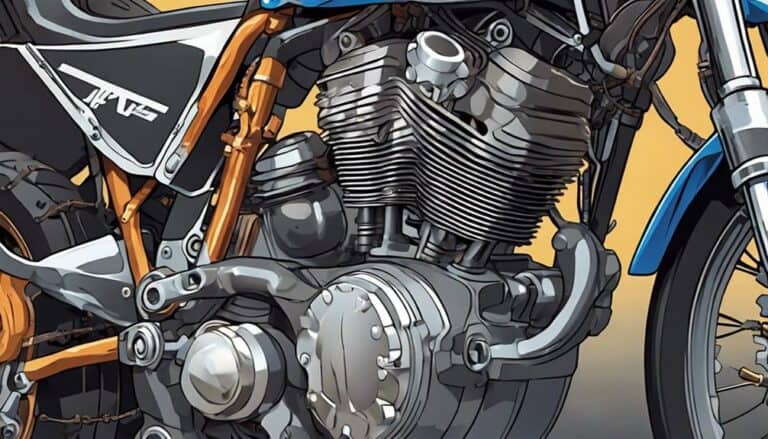Imagine your dirt bike is a symphony, and the crank serves as the conductor orchestrating the power to your wheels.
But what exactly is this mysterious crank on your dirt bike? Understanding its role can be the key to discovering the full potential of your machine.
Let's unravel the complexities of this essential component together.
Key Takeaways
- The crank on a dirt bike converts piston motion to rotational energy for driving the wheels.
- It plays a vital role in transferring power efficiently, enhancing engine performance.
- Crankshaft material impacts engine efficiency and power output significantly.
- Regular maintenance and inspection are crucial to ensure the crankshaft functions optimally and lasts longer.
Definition of Dirt Bike Crank
The dirt bike crank, an essential mechanical element, serves the important function of converting the piston's vertical motion into rotational energy to propel the bike forward. At the heart of this system lies the crankshaft, a meticulously crafted shaft that plays a pivotal role in the operation of the engine. The crankshaft isn't merely a static component but a dynamic force in motion. Its offset throws move in synchrony with the piston, orchestrating a dance of precision that transforms linear motion into the rotational power needed to drive the wheels.
The crankshaft's design is intricate, with each element meticulously engineered to withstand the intense forces and rapid movements within the engine. Connected to the piston through the connecting rod, the crankshaft guarantees that power is transferred efficiently, enabling the engine to operate smoothly and deliver peak performance. Regular maintenance and inspection of the crankshaft are critical to prevent wear and maintain the bike's overall performance at its peak.
Importance of Crankshaft in Performance
Converting the piston's vertical motion into rotational energy, the crankshaft in a dirt bike is a fundamental component that greatly influences engine performance and reliability. When it comes to engine rebuild, the importance of the crankshaft can't be overstated. Here are some key points highlighting the significance of the crankshaft in enhancing your dirt bike's performance:
- Conversion of Motion: The crankshaft transforms the linear motion of the piston into rotational motion, which drives the bike forward.
- Performance Enhancement: A high-quality crankshaft can greatly boost the engine's power output and overall performance.
- Vibration Reduction: Properly balanced crankshafts help decrease vibrations, preventing unnecessary stress on internal engine components.
- Precision Manufacturing: Precision machining and strict quality control during production ensure that the crankshaft meets strict standards for best performance.
- Maintenance Importance: Regular maintenance and inspection of the crankshaft are vital to guarantee its proper functioning and longevity, ultimately contributing to the engine's reliability.
Common Crankshaft Materials Used
Commonly utilized in dirt bikes, various materials are employed to manufacture crankshafts, including forged steel, aluminum, and titanium. Each material offers unique characteristics that impact the performance and durability of the crankshaft. The choice of material is vital in determining the overall performance of the engine. Here is a comparison of the common crankshaft materials used in dirt bikes:
| Material | Characteristics |
|---|---|
| Forged Steel | High strength and durability, ideal for performance |
| Aluminum | Lightweight, enhances engine responsiveness |
| Titanium | Exceptional strength-to-weight ratio, boosts performance |
The crankshaft material plays a significant role in the engine's efficiency and power output. The material's properties, such as strength, weight, and durability, directly impact the performance of the crank pin, ensuring smooth rotation and power delivery to the transmission. When selecting a dirt bike, understanding the crankshaft material can help you make an informed decision based on your riding preferences and performance requirements.
Signs of a Crankshaft Issue
Exhibiting excessive vibration or knocking noises while in operation can serve as early indicators of a potential crankshaft issue. When it comes to identifying problems with the crankshaft of your dirt bike, paying attention to the following signs is important:
- Oil leaks around the crankshaft seals or excessive oil consumption: These issues can suggest that there may be a problem with the crankshaft that needs attention.
- Difficulty starting the dirt bike or loss of power during acceleration: These symptoms could be a result of a faulty crankshaft affecting the engine's performance.
- Visible wobble or irregular movement of the connecting rod: If you notice this while the engine is running, it may indicate a malfunction in the crankshaft.
- Engine seizing or locking up: This severe consequence can occur due to a damaged or broken crankshaft, requiring immediate action.
- Unusual engine sounds or abnormal engine behavior: Any strange noises or behaviors could be a sign of underlying crankshaft issues that need to be addressed promptly.
Maintenance Tips for Dirt Bike Crankshaft
To maintain peak performance and longevity of your dirt bike's crankshaft, regular inspection for signs of wear, damage, or excessive play is crucial. Use a feeler gauge to check the crankshaft end play within the recommended tolerance range, typically between 0.004 to 0.012 inches, to guarantee proper function.
Verify that side-to-side play on the crankshaft falls within normal limits, as excessive vertical play may indicate underlying issues that need addressing. Adhere to the manufacturer's specifications and guidelines for maintenance intervals and procedures concerning the dirt bike's crankshaft.
If you detect any unusual noises, vibrations, or irregularities related to the crankshaft during operation, seek professional assistance or consult the dirt bike's manual promptly. Addressing potential issues early can prevent further damage and extend the lifespan of your dirt bike's crankshaft.
Conclusion
To summarize, the crankshaft on a dirt bike is the powerhouse that converts piston motion into wheel-spinning energy. Just like a conductor leading an orchestra, the crankshaft orchestrates the symphony of power delivery and acceleration in your bike.
Remember to give your crankshaft the care and attention it deserves to keep your dirt bike running smoothly and efficiently. It's the beating heart of your machine, so treat it well for peak performance on the trails.

